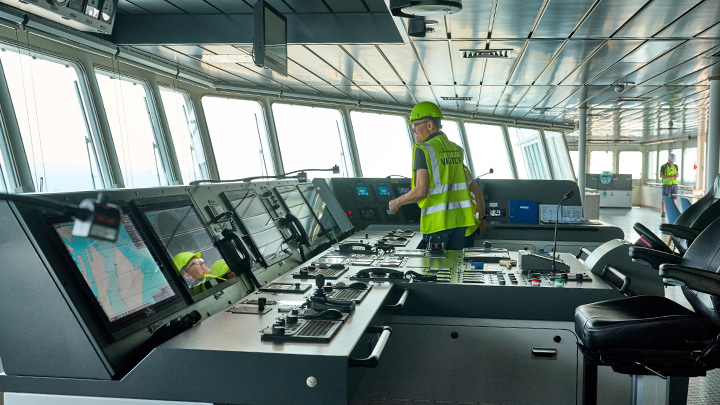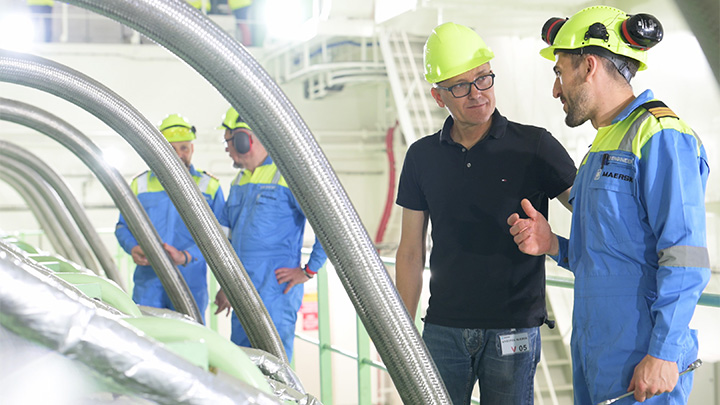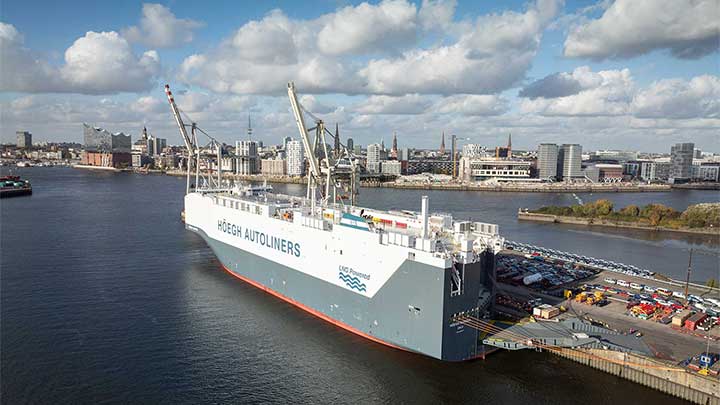MAN B&W ME-LGIM dual-fuel engines enable carbon-neutral transportation
A.P. Møller-Mærsk's order for 25 large container vessels to be powered by methanol is an important step in the decarbonization of the shipping industry. Aboard the brand-new Antonia Mærsk, propelled by an MAN B&W ME-LGIM dual-fuel engine, the crew is excited to push the button and use green methanol.
By Niels Anner
The panorama is breathtaking. From the bridge, the view sweeps across the glistening blue Kattegat Strait. In the background, there is the sound of squeaks, bangs and rattles. With great precision and speed, cranes in the Danish port of Aarhus are lifting thousands of containers onto the ship.
After being christened in Aarhus, the Antonia Mærsk is being loaded for her second long journey. On its maiden voyage, the 350-meter container ship with a capacity of 16,500 TEU sailed from the shipyard in Korea to Europe. Now it is on her way back to Asia, once again powered by green methanol, which reduces greenhouse gas emissions by up to 90 percent.

With the smell of fresh paint still in the air, the Antonia Mærsk is ushering in a new era: It is the third large merchant vessel to be powered by MAN Energy Solutions' G95ME-C10.5-LGIM dual-fuel engine - and leading shipping company A.P. Møller-Mærsk has already ordered a further 22 ships capable of sailing on green methanol, thus enabling low emission transportation.
"These orders are pivotal to the momentum we are now seeing in decarbonization," says Thomas Hansen, Head of Two-Stroke Sales & Promotion, MAN Energy Solutions Copenhagen. "Mærsk's bold move to focus on large methanol-powered container ships has really kicked off a trend in the market. We have received more than 200 orders for such engines, not only for container ships, but also for bulk carriers, tankers and pure car and truck carriers".
Seamless switch to methanol at the touch of a button
From the bridge and the accommodations, which in Antonia Mærsk's brand-new design are located at the very front, a number of stairs and a long corridor lead past the cargo hold with the containers. These are stacked ten tiers high below deck alone.
At the stern, in the engine room below the water surface, is the most valuable piece: the ME-LGIM, with its 95 cm cylinder bore-size, the world's largest methanol engine. Chief engineer Ireneusz Jan Urbanczyk smiles with delight as he looks down at the engine, only a quarter of which is visible – it is actually five stories high. The 60-year-old has seen a lot in shipping, having started his career in sailing with a vessel powered by a steam turbine. Now he is proudly experiencing the transition from conventional fuel to methanol.
The engine is very smooth and runs quietly on methanol, with very little vibration
When the ship is out of port, he and his crew switch from the primary fuel oil to methanol at the touch of a button; the fuel change is automatic and seamless, with no impact on the engine or its output. "It is very smooth and runs quietly on methanol, with very little vibration," says Urbanczyk as he explains some of the ME-LGIM's new features: the brown pipes for the methanol, double-walled for safety, and the three additional injection valves on the eight cylinders. Next to the engine room, there are the two fuel tanks, each with a capacity of almost 6,000 tons, holding enough green methanol for the voyage to Asia.

Training and a good partnership
"The main difference to engines running on conventional fuel is that we can now reduce emissions significantly," says Urbanczyk. "It's a good feeling that we can hopefully contribute to making the world a better place for our grandchildren." He senses a lot of public interest in the new ship: "There's so much debate about CO2 emissions – we can really make a difference." The latest version of MAN Energy Solutions’ exhaust gas recirculation system, which reduces NOx emissions, also contributes to this, says Torleif Simonsen, Antonia Mærsk's other chief engineer. “Having the latest technology on board, including the engine control room, is a great thing,” he says.
Even though the engine is based on the proven dual-fuel platform from MAN Energy Solutions, methanol operation does pose some new requirements for the engineers, such as the maintenance of the additional parts. But the crew has been well prepared, with visits to the shipyard and the MAN PrimeServ Academy in Copenhagen, where they also practiced on the engine simulator. "We are still in regular contact with MAN Energy Solutions and have a very good working partnership," says Simonsen. The crew has also received special training in handling methanol, whose toxicity requires special safety measures. These include methanol detectors, personal protective equipment and automatic system checks to avoid potentially dangerous situations.
Of the alternatives to fuel oil, methanol is the most convenient to use today, says Simonsen: "It is the closest to conventional fuel and comparatively easy to work with both on board and in ports." Methanol has long been used as a chemical in various industries, and its handling costs are low, with well-established storage and bunkering. Green methanol is seen as the best scalable clean fuel solution for this decade.
Methanol is the closest to conventional fuel and comparatively easy to work with
Growing green methanol production capacity
However, the question remains whether production can meet demand, as only green methanol - produced with renewable electricity and biogenic or captured CO2 - is carbon neutral. "Today, there is sufficient supply for the methanol engines already ordered," says Thomas Hansen, "and we see global capacity growing exponentially."
With stricter emissions regulation for the shipping industry soon to be adopted by the International Maritime Organization, he expects more final investment decisions for production sites. This will help green fuels like methanol make the definitive breakthrough, says Hansen, with the price, which is higher than for conventional fuel today, leveling off. MAN Energy Solutions is supporting this development with products for the supply chain, such as hydrogen generation technology, compressors and other equipment, he adds.

The engines for the maritime energy transition are ready, also as a retrofit option, with the first retrofit of the large methanol engine currently underway. "We are sure that this is an option that many shipowners are looking at," says Hansen.
In the engine room, he is excited to see the result of a long development process: In 2016, the MAN B&W's ME-LGIM two-stroke dual-fuel engine entered service as the world's first to power methanol carriers. Since then, it has accumulated more than 600,000 operating hours on methanol alone. What now powers the massive Antonia Mærsk with green methanol, saving 130,000 tons of CO2 annually, says Hansen, "is a culmination of our designs that have proven reliable and user-friendly for many years."
Mærsk's bold move to focus on large methanol-powered container ships has really kicked off a trend in the market.
About the author
Niels Anner is an independent journalist based in Copenhagen. He writes about science, health, technology, business and society in Northern Europe.
The world’s first two-stroke methanol engine
The MAN B&W ME-LGIM two-stroke dual-fuel engine can run on methanol as well as conventional fuels. Available either for newbuilds or for upgrading existing conventional fuel vessels, this engine represents a proven, refined engine design based on over 600,000 running hours on methanol alone. It is a versatile and scalable solution that is suited to a wide range of vessel types and has the potential to be carbon-neutral, making it an attractive option for meeting decarbonization targets.
Explore more topics
-

Hoegh - LNG-powered car carrier
With its first LNG-powered car carrier, Höegh Autoliners is taking a big step towards its target of net-zero by 2040. The centerpiece of the vessel is a MAN Energy Solutions MAN B&W ME-GI dual-fuel engine.
-

Maersk Halifax Retrofit
The world’s first methanol retrofit of the Very Large Container Vessel Maersk Halifax opens the doors for green fuels.
-

Methanol dual fuel retrofit
Engineers are now testing a retrofit for four-stroke ship engines that will enable ferry and cruise ship operators to meet the growing requirements on emission reduction with green methanol.
MAN Energy Solutions is now Everllence.
We have adopted a new brand name and moved to a new domain: www.everllence.com. This page will also be relocated there shortly. We are working on shifting all pages to www.everllence.com.
